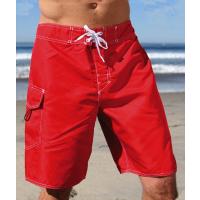 Ergonomics is a fancy word for scientific studies conducted to understand the interactions of humans and other elements of a system. The ergonomics study done recently for lifeguard personnel questioned what color uniform (boardshorts or swim suits) lifeguards or other first responders should wear to be noticed in a crowd.
Ergonomics is a fancy word for scientific studies conducted to understand the interactions of humans and other elements of a system. The ergonomics study done recently for lifeguard personnel questioned what color uniform (boardshorts or swim suits) lifeguards or other first responders should wear to be noticed in a crowd.
In 2009 the study declared that fluorescent colors, including yellow-green and orange, are easiest to spot in daylight and lime shades easiest to see in low lighting. So should all lifeguards and first responders wear fluorescent colors to be easily recognized in crowd?
Florescent Lifeguard Uniforms
Do the traditional color lifeguard boardshorts or Lifeguard swimming suits standout enough to gather attention and demand control when needed? In the early 70’s a lifeguard ad promoted a new trend of florescent bright as the sun orange, yellow and lime lifeguard trunks. The lifeguard agency tried it for a year and returned to standard red shorts because no one associated the florescent lifeguard apparel with true first responders. The U.S. Fire Administration replaced red fire trucks and beach emergency vehicles with lime-yellow fire vehicles with white upper cabs. This action, even though the vehicles could be seen better, started trouble because people in the community did not associate the color lime with fire trucks or the yellow-green vehicles as emergency vehicles. A battle began between the community and fire department. The community ordered an ergonomic study which confirmed that fluorescent yellow-green and orange greatly increased vehicle visibility, but the report also concluded that the public did not associate the emergency vehicles with the new colors and recommended that public association was more important than paint color.
Do Lifeguard Uniforms Matter?
In the early years of lifeguarding, fishermen were recruited to be lifeguards. Each morning after going fishing in the morning the fishermen wearing their fishing clothes became lifeguards and used their boats as lifesaving devises. The fishermen encountered several problems as they tried to help the distressed swimmers. They struggled to control their small boats in windswept choppy waters and getting the swimmer into the boat was a difficult problem. But the biggest problem was that the general public didn’t respect the fishermen and called them a nuisance. It was so bad that when a distressed swimmer was in trouble they refused help from the fishermen until they passed out in the water. The fishermen lifeguards went to the lifeguard board with their dilemma. The counsels’ answer to the problem was to give them a lifeguard uniform, which seemed to resolve the respect problem.
A state beach in Florida received a complaint letter from a mother stating the trouble she had while at the beach with her kids. One of her children had drifted out to far into the water and she tried to find a lifeguard in the crowd. No lifeguard was to be found, no uniformed lifeguards were anywhere to be seen. Her child was pulled back to shore by an onlooker. The beach supervisor replied he was sorry the mother could not find a lifeguard, but it was their policy to let the lifeguards pick out their own swimwear, so as it turned out the female lifeguard was mixed in with the 100’s of people on the beach.
Introducing the Yellow Lifeguard Uniform
Colors play an important part in our daily lives. Colors evoke feelings, emotions, memories and provide warnings of potential hazards and dangers. But are the colors particularly important, or is it more important having a lifeguard uniform that is distinctive and the same throughout the respective areas? All lifeguards at any facility, beach, or recreation area should wear corresponding uniforms. Lifeguard uniforms give the appearance they are rescue ready, and give the look of authority, making them easy to identify by visitors. Lifeguards must stand out and be easily recognizable in huge crowds. Aquatic facilities and Waterparks have increased in size and numbers. Waterparks can span as much as 35 or more acres and can support staff of 250 or more. Red, blue, and black lifeguard uniforms may no longer have a place in these aquatic facilities. Florescent safety yellow for lifeguard uniforms has benefits that support everything from lifeguard safety to guest satisfaction. Safety yellow lifeguard uniforms do have advantages over the present-day uniforms because florescent safety yellow allows lifeguards to be seen across the large facilities. More important it helps lifeguards find their closest teammate for support when they need it. Red, navy, and black have been the lifeguard uniform colors of choice, but as the industry and profession moves forward, someone will still have to answer the question, should lifeguards wear red anymore?


